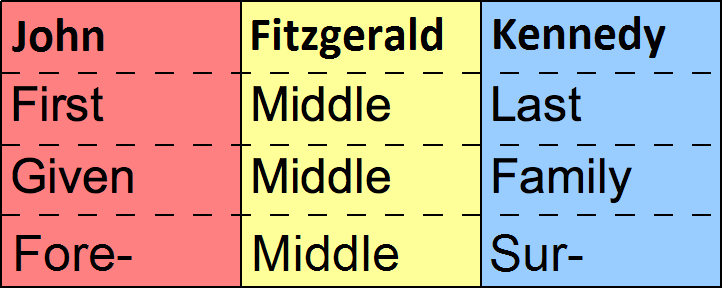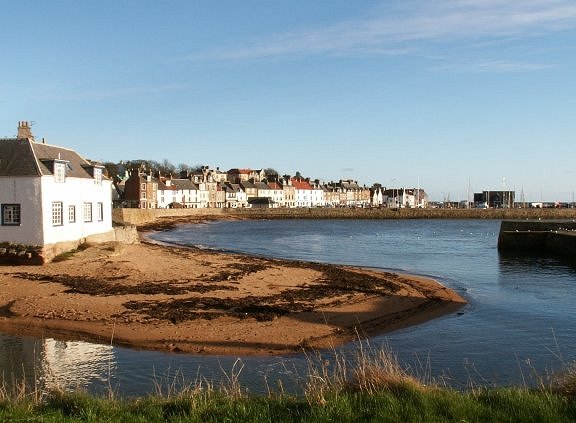|
Topographic Name
A toponymic surname or habitational surname or byname is a surname or byname derived from a place name,"Toponymic Surnames as Evidence of the Origin: Some Medieval Views" , by Benjamin Z. Kedar.Last Names and Their Meanings '''' which included names of specific locations, such as the individual's place of origin, residence, or lands that they held, or, more generically, names that were derived from regional topographic features. |
Surname
In many societies, a surname, family name, or last name is the mostly hereditary portion of one's personal name that indicates one's family. It is typically combined with a given name to form the full name of a person, although several given names and surnames are possible in the full name. In modern times most surnames are hereditary, although in most countries a person has a right to name change, change their name. Depending on culture, the surname may be placed either at the start of a person's name, or at the end. The number of surnames given to an individual also varies: in most cases it is just one, but in Portuguese-speaking countries and many Spanish-speaking countries, two surnames (one inherited from the mother and another from the father) are used for legal purposes. Depending on culture, not all members of a family unit are required to have identical surnames. In some countries, surnames are modified depending on gender and family membership status of a person. C ... [...More Info...] [...Related Items...] OR: [Wikipedia] [Google] [Baidu] |
Van (Dutch)
''van'' () is a very common prefix in Dutch language surnames, where it is known as a . In those cases it nearly always refers to a certain, often quite distant, ancestor's Toponymic surname, place of origin or residence; for example, Ludwig van Beethoven, Ludwig ''van Beethoven'' "from Beethoven" (maybe Bettenhoven) and Rembrandt van Rijn, Rembrandt ''van Rijn'' "from the Rhine". ''Van'' is also a preposition in the Dutch language, Dutch and Afrikaans language, Afrikaans languages, meaning "of" or "from" depending on the context (similar to ''wikt:da, da'', ''wikt:de, de'', ''wikt:di, di'' and ''wikt:di, do'' in the Romance languages). In surnames, it can appear by itself or in combination with an Article (grammar), article (compare French language, French ''de la'', ''du'', ''de l). The most common cases of this are ''van de'', ''van der'' and ''van den'', where the articles are all current or archaic forms of the article ''de'' "the". Less common are ''van het'' and ''van 't' ... [...More Info...] [...Related Items...] OR: [Wikipedia] [Google] [Baidu] |
Maliszewo
Maliszewo is a village in the administrative district of Gmina Lipno, within Lipno County, Kuyavian-Pomeranian Voivodeship * Kuyavian-Pomeranian Voivodeship is one of the 16 voivodeships (provinces) in Poland. * Kuyavian-Pomeranian is one of 13 Polish constituency of the European Parliament. * Kuyavian-Pomeranian Regional Assembly is the regional legislature of t ..., in north-central Poland. References Villages in Lipno County {{Lipno-geo-stub ... [...More Info...] [...Related Items...] OR: [Wikipedia] [Google] [Baidu] |
Maliszew
Maliszew is a village in the administrative district of Gmina Mińsk Mazowiecki, within Mińsk County, Masovian Voivodeship Masovian Voivodeship or Mazowieckie Province (, ) and any variation thereof, is a Voivodeships of Poland, voivodeship (province) in east-central Poland, containing Poland's capital Warsaw. Masovian Voivodeship has an area of and had a 2019 po ..., in east-central Poland. References Villages in Mińsk County {{Mińsk-geo-stub ... [...More Info...] [...Related Items...] OR: [Wikipedia] [Google] [Baidu] |
Maliszewski
Maliszewski ( ; feminine: Maliszewska; plural: Maliszewscy) is a surname of Polish-language origin. It is a toponymic surname associated with one of the places in Poland named Maliszew, Maliszewo Maliszewo is a village in the administrative district of Gmina Lipno, within Lipno County, Kuyavian-Pomeranian Voivodeship * Kuyavian-Pomeranian Voivodeship is one of the 16 voivodeships (provinces) in Poland. * Kuyavian-Pomeranian is one of 13 ..., or Maliszów. the Lithuanianized version is Mališauskas. The Russian-language versions of the surnames are Malishevsky (masculine), Malishevskaya (feminine). Notable people with this surname include: * Anna Maliszewska (born 1993), Polish modern pentathlete * Karol Maliszewski (born 1960), Polish poet, prose writer, literary critic * Natalia Maliszewska (born 1995), Polish short track speed skater * Patrycja Maliszewska (born 1988), Polish short-track speed skater * Łukasz Maliszewski (born 1985) Polish footballer * Miros� ... [...More Info...] [...Related Items...] OR: [Wikipedia] [Google] [Baidu] |
Name Of Joan Of Arc
Due to inconsistent record keeping and different contemporary customs, the name of Joan of Arc at birth is not known for certain. Explanation Joan of Arc did not hail from a place called Arc, contrary to popular belief, but was born and raised in the village of Domrémy in what was then the northeastern frontier of the Kingdom of France. In the English language her first name has been repeated as ''Joan'' since the fifteenth century because that was the only English equivalent for the feminine form of ''John'' during her lifetime. Her surviving signatures are all spelled in the middle French form ''Jehanne'' without surname. In modern French, her name is always rendered as ''Jeanne d'Arc'', reflecting spelling changes due to the evolution of the language over time. Her given name at birth is also sometimes written as "Jeanneton" or "Jeannette", with Joan of Arc possibly having removed the diminutive suffix ''-eton'' or ''-ette'' in her teenage years. The surname ''of Arc'' is ... [...More Info...] [...Related Items...] OR: [Wikipedia] [Google] [Baidu] |
Patronymic
A patronymic, or patronym, is a component of a personal name based on the given name of one's father, grandfather (more specifically an avonymic), or an earlier male ancestor. It is the male equivalent of a matronymic. Patronymics are used, by custom or official policy, in many countries worldwide, although elsewhere their use has been replaced by or transformed into patronymic surnames. Examples of such transformations include common English surnames such as Johnson (surname), Johnson (son of John). Origins of terms The usual noun and adjective in English is ''patronymic'', but as a noun this exists in free variation alongside ''patronym''. The first part of the word ''patronym'' comes from Greek language, Greek πατήρ ''patēr'' 'father' (Genitive case, GEN πατρός ''patros'' whence the combining form πατρο- ''patro''-); the second part comes from Greek ὄνυμα ''onyma'', a variant form of ὄνομα ''onoma'' 'name'. In the form ''patronymic'', this stand ... [...More Info...] [...Related Items...] OR: [Wikipedia] [Google] [Baidu] |
Jeanne D'Arc
Joan of Arc ( ; ; – 30 May 1431) is a patron saint of France, honored as a defender of the French nation for her role in the siege of Orléans and her insistence on the Coronation of the French monarch, coronation of Charles VII of France during the Hundred Years' War. Claiming to be acting under divine guidance, she became a military leader who transcended gender roles and gained recognition as a savior of France. Joan was born to a propertied peasant family at Domrémy-la-Pucelle, Domrémy in northeast France. In 1428, she requested to be taken to Charles VII, later testifying that she was guided by visions from the archangel Michael, Margaret the Virgin, Saint Margaret, and Catherine of Alexandria, Saint Catherine to help him save France from English domination. Convinced of her devotion and purity, Charles sent Joan, who was about seventeen years old, to the siege of Orléans as part of a relief army. She arrived at the city in April 1429, wielding her banner a ... [...More Info...] [...Related Items...] OR: [Wikipedia] [Google] [Baidu] |
Badgworthy Water
Badgworthy Water is a small river which flows through Malmsmead on Exmoor, close to the border between Devon and Somerset, England. It merges with Oare Water to become the East Lyn River. On the banks of the river are the remains of a few dwellings which formed a medieval village. The last resident left in the 1820s. The 17th century packhorse Malmsmead Bridge crosses Badgworthy Water, alongside an even older ford. The valley is associated with the book '' Lorna Doone''. It has been used for canoe A canoe is a lightweight, narrow watercraft, water vessel, typically pointed at both ends and open on top, propelled by one or more seated or kneeling paddlers facing the direction of travel and using paddles. In British English, the term ' ...ing and includes grade 2 and 3 rapids, walking and fly fishing. References External links * {{authority control Rivers of Somerset Exmoor 1Badgworthy ... [...More Info...] [...Related Items...] OR: [Wikipedia] [Google] [Baidu] |
Anstruther
Anstruther ( ; ) is a coastal town in Fife, Scotland, situated on the north-shore of the Firth of Forth and south-southeast of St Andrews. The town comprises two settlements, Anstruther Easter and Anstruther Wester, which are divided by a stream, the Dreel Burn. With a population of 3,500, it is the largest community on the Firth of Forth's north-shore coastline known as the East Neuk. To the east, it merges with the village of Cellardyke. Description Founded as a fishing village, Anstruther is home to the Scottish Fisheries Museum. Recreational vessels are now moored in the harbour, and a Golf, golf course is situated near the town. Anstruther Pleasure Cruises operate sightseeing/wildlife cruises from the harbour to the Isle of May, the UK's primary puffin location, on board the vessel the ''May Princess'' from April to October. An abundance of other wildlife, including seal colonies, also inhabit the island. The Waid Academy, the local state comprehensive school, is a focu ... [...More Info...] [...Related Items...] OR: [Wikipedia] [Google] [Baidu] |
Wymondham
Wymondham ( ) is a market town and civil parishes in England, civil parish in the South Norfolk district of Norfolk, England. It lies on the River Tiffey, south-west of Norwich and just off the A11 road (England), A11 road to London. The parish, one of Norfolk's largest, includes rural areas to the north and south, with hamlets of Suton, Silfield, Spooner Row and Wattlefield. It had a population of 14,405 in 2011, of whom 13,587 lived in the town itself. Development The community developed during the Anglo-Saxon settlement of Britain, Anglo-Saxon period and expanded with the establishment of a Wymondham Abbey, priory in 1107 and a market in 1204. Industrially, Wymondham became known as a centre of woodturning and brush-making, retaining its brush factories until the late 20th century. New housing to the north and east of the town centre brought rapid expansion. Dual carriageways for the A11 and the development of rapid rail links to Norwich and Cambridge means Wymondham is no ... [...More Info...] [...Related Items...] OR: [Wikipedia] [Google] [Baidu] |
Nobiliary Particle
A nobiliary particle is a type of onomastic particle used in a surname or family name in many Western cultures to signal the nobility of a family. The particle used varies depending on the country, language and period of time. In some languages, it is the same as a regular prepositional particle that was used in the creation of many surnames. In some countries, it became customary to distinguish the nobiliary particle from the regular one by a different spelling, although in other countries these conventions did not arise, occasionally resulting in ambiguity. The nobiliary particle can often be omitted in everyday speech or certain contexts. Denmark and Norway In Denmark and Norway, there is a distinction between (1) nobiliary particles in family names and (2) prepositions denoting an individual person's place of residence. Nobiliary particles like af, von, and de (English: ''of'') are integrated parts of family names. The use of particles was not a particular privilege for ... [...More Info...] [...Related Items...] OR: [Wikipedia] [Google] [Baidu] |



